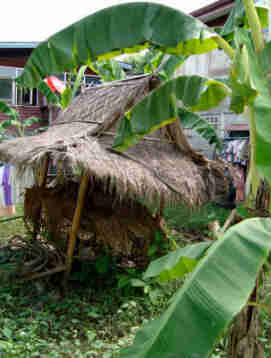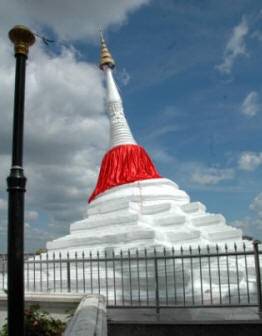Home › Diving › Thailand › Central › Bangkok › Attractions › Koh Kret Island
Ko Kret Island Bangkok Thailand
Koh Kret Island is a car-less island in the middle of Chao Phraya river North of Bangkok (20km) Nonthaburi Province.
If you are thinking of "Ko Kret - Tropical Island", then you need to head further south than Bangkok.
Pottery on Koh Kret Island Bangkok
Yes, it has banana trees, and palms and the odd shanty shack, but tropical Island, Koh Kret is not! It was never really intended that it should be an Island.
It just happened to be a piece of land that needed to be circumnavigated with some water.
That there were people living there, and have lived there since, probably did not enter the equation when it was decided to make a shortcut for the Chao Phraya "River of Kings".
So, Ko Kret Island is the result of a little bit of waterway engineering that started back in 1722.
It was decided to make a canal 'short-cut' to avoid a long, severe bend in the Chao Phraya river.
Over the years, the canal has been widened both manually and by natural erosion of the river waters, resulting in a considerable width of water to now justify the area of Koh Kret as a true island.
The main ferry pier landing area is near to everything that happens on this small island, but it would be sacrilege simply to stay in this 'tourist' area. Ko Kret is a wonderful community of friendly people, living in a world that has for the most part passed them by.
On the plus side, there is tranquillity and friendship on Ko Kret Island, on the minus side, tourists - both Thai and foreign - tend to flock to the island - particularly at weekends.
Bananas and Shanty Shacks
One very interesting characteristic of the Ko Kret Island, is the fact that it is totally devoid of cars. Bicycles and feet being the normal mode of transport.
 Bearing in mind that the Ko Kret Island is just upstream from Bangkok, then the lack of cars for many will be both a blessing and a novelty.
Bearing in mind that the Ko Kret Island is just upstream from Bangkok, then the lack of cars for many will be both a blessing and a novelty.
Rush hour on the island is as fast or as slow as you want to make it! Watch out for the odd motorbike (I saw two in four hours), and the vendor's hand pushed carts with various goods (and bads) for sale.
There are some lovely locally made items for sale - including earthenware trinkets and the like.
But, as with all things Thai, the imported plastics are also finding their way onto the island.
The island is about two (2) kilometres across - hardly room for a three point turn - and a convenient footpath runs right around the perimeter. It takes a couple of hours of lazy walking to do the walk around Ko Kret. Longer if you are interested in all that is going on there.
You can also hire a bike. Walking or cycling are the two options. Walking is best, for much of the time you will have to get off your bike anyway.
As Ko Kret is an Island, there will be water surrounding you wherever you go - sometimes lapping at the edge of - or over - the track that you are walking. (It would be stretching the imagination to talk about roads on Ko Kret!)
Where there is water, there will be mosquitoes or other assorted midges that seem to favour the skin and blood of western tourists. Cover as much as you can.
Eating on Koh Kret Island
Ko Kret is rightly renowned for the food it serves up - whether from a couple of barrels upturned, with a plank of wood or a tin sheet acting as counter, or at one of the 'sit-down' places near the main market/landing area.
Much of the food to be had has a local flavour with historic leanings towards the Mon people who largely inhabit the island. There are several delicious local-made sweets that just ache to be tried.
Don't fill up at the first stall, for there will be others to try en-route. Then you will have either started, finished your trip near the market.
The main inhabitants of the island of Ko Kret, are ancestors of the Mon Tribes who were commonplace in central Thailand in the middle sixth - tenth centuries. The Mons have their own distinct form of Buddhism - with more emphasis on superstition and astrology than their Thai cousins.
Spirits are an important part of the "Mon" form of Buddhism. They are also adept with their pottery making skills - a main source of income for many of the inhabitants of the Ko Kret Island. The clay for the hand-thrown earthenware pottery is gathered locally from the Island.
One has to wonder how long the Mons can excavate their local clay without causing further erosion problems - especially as tourists and Thais alike, are happy to take a bit of the Island home with them, by way of a choice piece of locally crafted pottery.
Most of the earthenware pottery on Koh Kret can be sought out at the small individual potters along various lanes and footpaths.
Kiln baked unglazed terra cotta best describes the engineering side of the pottery business, but there are some fine ornate specimens, but also simple candle holders and incense burners. Anything from a few baht to a few thousand baht.
There is also a Thai OTOP system with stunning displays of the locally-made Terracotta. More than likely, you will see one of the craftsmen/women hand-carving the clay before it enters the kilns.
This is painstakingly detailed work carried out by devoted experts, with skills handed down through many generations on Ko Kret.
English is not an often heard language on Ko Kret Island, but some of the direction signs have English writing on them. This will probably expand, as the influx of English-speaking tourists does.
 Don't go to Ko Kret looking for excitement - other than a bit of haggling. Take it easy in this slowly modernising area near Bangkok.
Don't go to Ko Kret looking for excitement - other than a bit of haggling. Take it easy in this slowly modernising area near Bangkok.
Wooden shacks aplenty give it an old eastern charm which is rapidly disappearing further down the river.
The favoured Wat on the Ko Kret Island, is Wat Paramai Yikawat - also known as Wat Mon - several pagodas of white marble, together with a Mon-style Marble Buddha.
It is well known - being the central point of all things tourism on the Island.
Near the marketplace and temple you will find the leaning Chedi - accident or engineering marvel it matters not. It is interesting.
Some say that the base is constructed - nay hewn - out of marble. If that turns you on, then fine. Marble - white or not, does not normally have to be painted regularly with exterior grade emulsion paint.
If you go inside the temple - and you should, then cast your eyes upwards to see the beautiful ceiling. Don't plan on staying for a long weekend, or even overnight. No guesthouses or the like. Though you can do a residential yoga course for a few days.